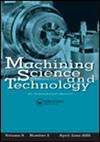Reduced computational time in 3D finite element simulation of high speed milling of 6061-T6 aluminum alloy
IF 2.6
4区 工程技术
Q2 ENGINEERING, MANUFACTURING
引用次数: 5
Abstract
Abstract The finite element method is an important supplement to the experiment on the research of metal cutting mechanism. A 3D thermo-mechanical coupling model was established based on ABAQUS, in which a model of the tool with real structure and a simplified model of the work-piece based on the cutting zone were established. It can greatly improve the computational efficiency because the volume of the work-piece model can be reduced by 70% when compared with the traditional rectangle model. The validation shows that the prediction error of the cutting force is less than 15%, and the prediction results of the chip morphology are in good agreement with the experiment results. In order to reveal the mechanism of high speed milling of 6061-T6 Aluminum alloy, single factor experiments were carried out based on the established model. The results show that the cutting force and cutting temperature rapidly increase with the increase of the axial depth of cut ap and the feed per tooth fz , but slowly increase with the increase of the radial depth of cut ae . The cutting force decreases with the increase of the spindle speed n. However, the cutting temperature increases with the increase of n firstly, and tends to be stable when n is over than 10,000 r/min. GRAPHICAL ABSTRACT减少了6061-T6铝合金高速铣削三维有限元模拟的计算时间
摘要有限元法是对金属切削机理实验研究的重要补充。基于ABAQUS建立了三维热机械耦合模型,建立了具有真实结构的刀具模型和基于切削区的工件简化模型。与传统的矩形模型相比,工件模型的体积可以减少70%,从而大大提高了计算效率。验证表明,切削力的预测误差小于15%,切屑形态的预测结果与实验结果吻合良好。为了揭示6061-T6铝合金的高速铣削机理,在建立的模型基础上进行了单因素实验。结果表明,切削力和切削温度随着轴向切削深度ap和每齿进给量fz的增加而迅速增加,但随着径向切削深度ae的增加而缓慢增加。切削力随主轴转速n的增加而减小,但切削温度首先随转速n的增大而增大,当转速n大于10000r/min时趋于稳定。图形摘要
本文章由计算机程序翻译,如有差异,请以英文原文为准。
求助全文
约1分钟内获得全文
求助全文
来源期刊

Machining Science and Technology
工程技术-材料科学:综合
CiteScore
5.70
自引率
3.70%
发文量
18
审稿时长
6 months
期刊介绍:
Machining Science and Technology publishes original scientific and technical papers and review articles on topics related to traditional and nontraditional machining processes performed on all materials—metals and advanced alloys, polymers, ceramics, composites, and biomaterials.
Topics covered include:
-machining performance of all materials, including lightweight materials-
coated and special cutting tools: design and machining performance evaluation-
predictive models for machining performance and optimization, including machining dynamics-
measurement and analysis of machined surfaces-
sustainable machining: dry, near-dry, or Minimum Quantity Lubrication (MQL) and cryogenic machining processes
precision and micro/nano machining-
design and implementation of in-process sensors for monitoring and control of machining performance-
surface integrity in machining processes, including detection and characterization of machining damage-
new and advanced abrasive machining processes: design and performance analysis-
cutting fluids and special coolants/lubricants-
nontraditional and hybrid machining processes, including EDM, ECM, laser and plasma-assisted machining, waterjet and abrasive waterjet machining
 求助内容:
求助内容: 应助结果提醒方式:
应助结果提醒方式:


